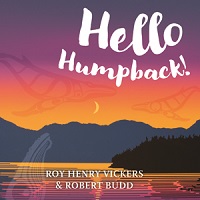| ________________
CM . . . . Volume XXIV Number 22. . . . February 9, 2018
excerpt:
Most board books are considered to be early learning tools that assist the very young in, for example, expanding their vocabulary, learning the alphabet or how to count from 1 to 10. Very loosely, Hello Humpback! could be considered to be in the “vocabulary-expanding” category, but it is much more than that. As the series’ title indicates, it is an introduction to the West Coast, and youngsters will encounter some of the region’s fauna: salmon, bears, humpback whales, ravens, otters, eagles and orcas. Additionally, viewers of the illustrations will get glimpses of the area’s geography: mountains, forests, rivers and seas. But most importantly, the illustrations in Hello Humpback! introduce children to the two-dimensional formline art style of the Northwest Coast’s original peoples. The board book is a combination of double-page spreads and pairs of facing pages. The text associated with an image is normally limited to two or three words which tell readers what the major visual focus of the page is to be. The sole exception to this pattern is the “OCEAN BLUE” spread that features 17 different things that would be found beneath the ocean’s surface, things such as rockfish, crabs and kelp, with each being rendered via formline art and labelled. My one quibble would be that, in the dozen instances of text being used, “Hello” is employed three times to introduce an animal – the title’s humpback, a school of salmon and an otter. Some of the pages exhibit a degree of embossing, and, for example, children can run their fingers over the salmon skeletons on the “BEARS AND TREES” spread and feel the salmon bones, or, on the closing spread, “SUN IN WEST”, they can touch the ripples on the water. In addition to the book’s use of an Indigenous art style, readers are subtly reminded of this land’s original inhabits via the incorporation of a totem pole on the “MOUNTAIN VIEW” page and the silhouette of a cedar canoe containing a quartet of paddlers wearing traditional woven hats on the “CALM SEAS” page. In short, Hello Humpback! serves as an introduction to an area, a culture and an art style, and its contents can likely be appreciated by an audience older than that normally associated with a board book. Highly Recommended. Dave Jenkinson, CM’s editor, lives in Winnipeg, MB.
Next Review |
Table of Contents for This Issue
- February 9, 2018. |
